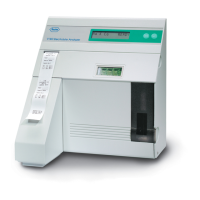v
METHOD SHEET
Intended Use
The AVL 9180 Electrolyte Analyzer is intended to be used for the measurement of sodium, potas-
sium, chloride, ionized calcium and lithium in samples of whole blood, serum, plasma, urine, dialy-
sate and aqueous standard solutions.
Clinical Significance
1,2
Sodium
Sodium is the major cation of extracellular fluid. Its primary functions in the body are to chemically
maintain osmotic pressure and acid-base balance and to transmit nerve impulses. Sodium functions
at the cell membrane level by creating an electrical potential between different cell membranes
causing the transmission of nerve impulses and neuromuscular excitability to be maintained. Sodium
is involved in some enzyme catalyzed reactions as a cofactor. The body has a strong tendency to
maintain a total base content, and only slight changes are found even under pathologic conditions.
Low sodium values, hyponatremia, usually reflect a relative excess of body water rather than a low
total body sodium. Reduced sodium levels may be associated with: low sodium intake; sodium losses
due to vomiting or diarrhea with adequate water and inadequate salt replacement, diuretics abuse, or
salt-losing nephropathy; osmotic diuresis, metabolic acidosis; adrenocortical insufficiency; congeni-
tal adrenal hyperplasia; dilution type due to edema, cardiac failure, hepatic failure; and
hypothyroidism.
Elevated sodium values, hypernatremia, are associated with conditions with water loss in excess of
salt loss through profuse sweating, prolonged hyperpnea, severe vomiting or diarrhea, diabetes
insipidus or diabetic acidosis; increased renal sodium conservation in hyperaldosteronism, Cushings
syndrome; inadequate water intake because of coma or hypothalamic diseases; dehydration; or
excessive saline therapy.
The sodium value obtained may be used in the diagnosis or monitoring of all disturbances of the
water balance, infusion therapies, vomiting, diarrhea, burns, heart and kidney insufficiencies, central
or renal diabetes insipidus, endocrine disturbances and primary or secondary cortex insufficiency of
the adrenal gland or other diseases involving electrolyte imbalance.
1
Tietz, Norbert W., Ed., Clinical Guide to Laboratory Tests, 2nd Ed., (Philadelphia: W.B.Saunders, Co., 1990)
p.98-99, 118-119, 456-459, 510-511, 720-721.
2
Burtis C, Ashwood E (Eds.), Tietz Textbook of Clinical Chemistry, 2nd Ed., (Philadelphia: W.B.Saunders, Co.,
1994) pp.1354-1370.

